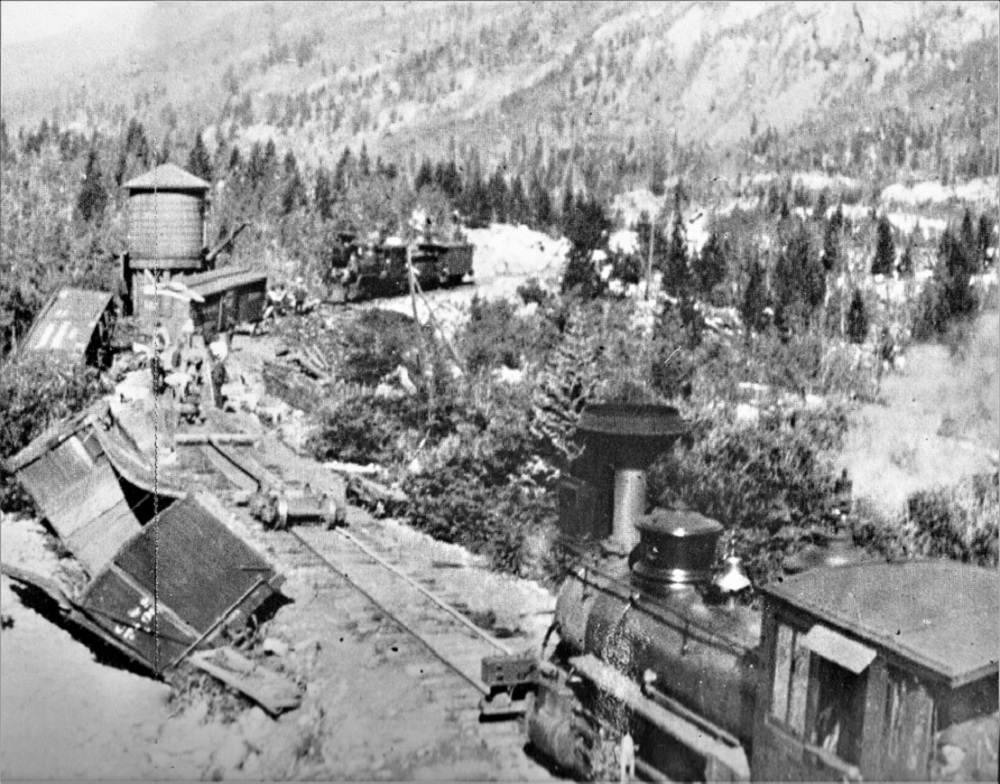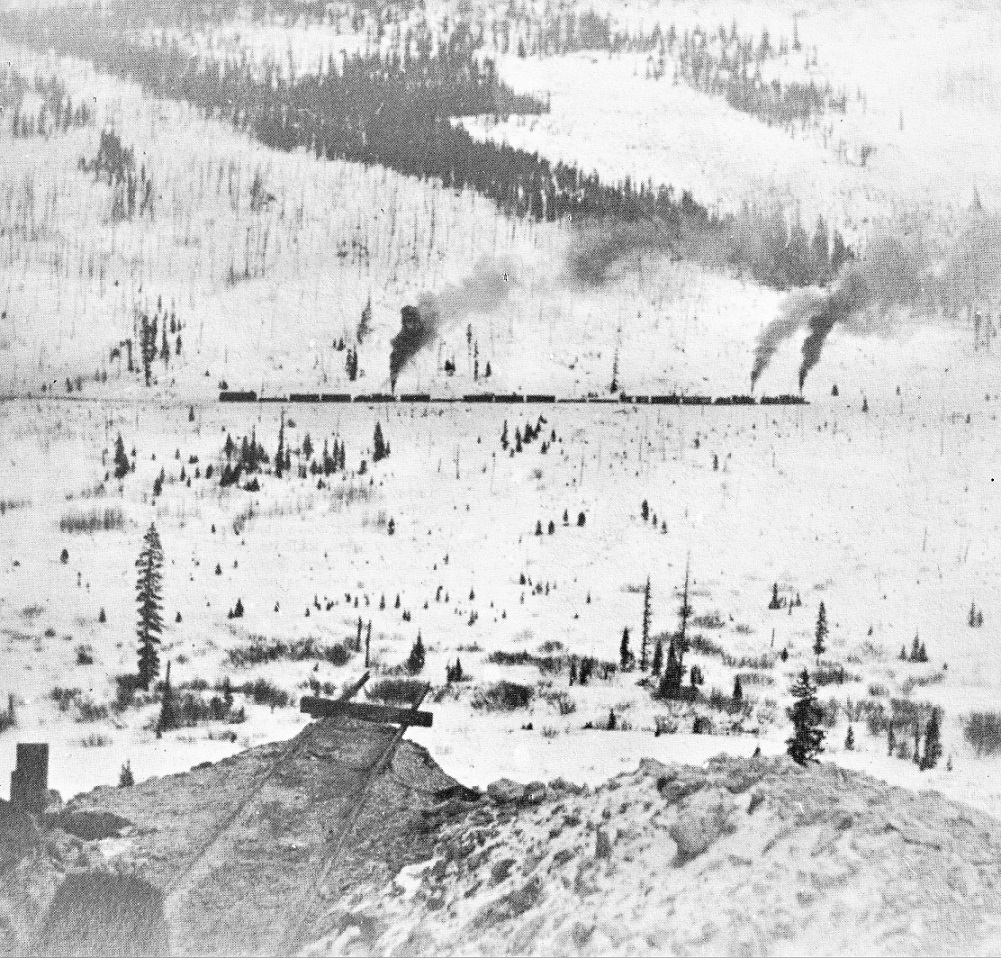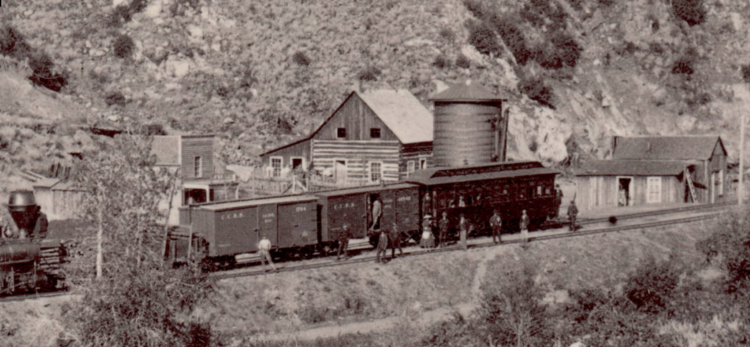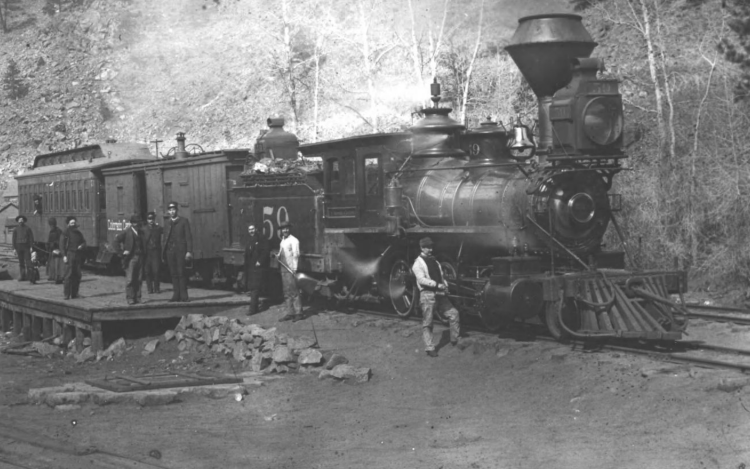Help Identify this Wreck Location
Help Identify this Wreck Location
|
This post was updated on .
I'm packing up stuff to put in storage, before the painters come. When I reached for my old copy of Dow Helmer's Historic Alpine Tunnel, it fell apart, all the pages separating from the binding. I looked through the photo section and set aside a number of pages to scan into my computer.
This photo of a wreck in early C&S days ran across the gutter of the book. I tried to stitch it together as best I could:  The wreck must have occurred between 1899 and 1903, given the link and pin couplers. The foreground locomotive is one of the Rhode Islands, probably C&S 62, given the wagon top boiler, the domes and what appears to be a "2" on the sand dome. The far locomotive appears to be one of the two Baldwin classes. The 4-wheel caboose is likely painted red -- does it have a short wheel base, John Greenly?? A 27 foot UP-built boxcar lies destroyed in the left foreground; a new St Charles boxcar in factory lettering is on its side, just this side of the water tank. The water tank seems smaller than the 30,000 gallon variety, but sits atop 4 sets of bents, I believe. The book caption is "near St Elmo". Can any one identify the location and the water tank?? _____________________________________________________ One other photo in Helmer's book, that I've not seen published elsewhere, is this snowscape:  The book caption states the photo was taken from the portal of the Gold Cup mine, above St. Elmo. The 14 car mixed train is climbing to Alpine Tunnel. The double header has a third locomotive helper cut in at the rear, 3 cars ahead of the combine. Date could be any time between 1904 and the winter of 1909-1910.
Jim Courtney
Poulsbo, WA |
Re: Help Identify this Wreck Location
|
Jim,
the Lady Murphy tank see 5th illustration in Rick's post http://c-sng-discussion-forum.41377.n7.nabble.com/Two-Railroad-Rosters-tp14478p14576.html I have a feeling this has been discussed on here before.......  Glad you corrected the picture, my copy of Dow Helmer's Historic Alpine Tunnel has it reversed.
UpSideDownC
in New Zealand |
Re: Help Identify this Wreck Location
|
Thanks Chris.
I was confused, as Mac Poor lists MP 154.78 as "Murphy Tank", described as a big 47,500 gal tank that was removed between 1886 and 1889. There was also a siding with 1,190 feet of track. It was the size of the tank that confused me -- the round roof tank in the photo is certainly not a big tank. I wondered if this was a small original South Park tank, but the chronology was all wrong: The equipment is early C&S 1899-1903, and per Poor there shouldn't be a tank here at that date, and if there was, why replace a big tank with such a small one? But, Rick's B&B roster certainly illustrates what happened:  As best as I can make out, the replacement tank had a tub that was 12 feet in diameter and 12 feet tall, capacity of 10,150 gallons, which pretty much matches the size of the small tank in the photo. The side notation indicates "This tank from . . .". Is the word Gunnison??? Was this a small tank from the round house area, later moved as Gunnison City water became available?? But Poor states that the tank at Gunnison was a big one of 47,500 gallons. The tank in the photo reminds me of the little tank at Jack's Cabin on the D&RG. And I agree, this discussion does feel familiar, somehow . . .
Jim Courtney
Poulsbo, WA |
Re: Help Identify this Wreck Location
|
This post was updated on .
Jim, take another look at the handwritten notes in the B&B book for St Elmo. "this tank from Crisman" is what's written in the right column: The tank is the GSL&P water tank from Crisman, CO, moved to St Elmo sometime between 1888 and 1891 and placed at Grizzly Gulch east of the St Elmo turntable.
The Murphy tank, Lady Murphy for a while, was a mile west of St Elmo and was the original tank in the area. I think the confusion comes from the crossing out of the tank in the B&B book. I'm not certain if it burned, like the one at Alpine (Fisher) did or what exactly happened--something I've read indicated the Lady Murphy tank remained after the Crisman tank was moved. Perhaps that location at Grizzly Gulch was more convenient, especially in the winter, rather than running up to Lady Murphy. One 1884-85 photo of Crisman shows the same tank, see DPL Z-5458 for a good copy--first picture below is a detail. It was a small tank, 10150 gallon. Later photos of Crisman show the tank gone and the water feed covered--second photo below is S-2531 from Boulder Historical Society.  
Dave Eggleston
Seattle, WA |
Re: Help Identify this Wreck Location
|
Dave,
something I've read indicated the Lady Murphy tank remained after the Crisman tank was moved. Perhaps that location at Grizzly Gulch was more convenient, especially in the winter, rather than running up to Lady Murphy. The C&S June, 1922 T.T. shows W(Tank) at the location for St Elmo, listed as 155.3 which differs from the B&B Handbook. fwiw Jim, I had to chuckle about your query on the "moved from" alteration, when I read through Rick's post and saw that, it did cross my mind whether you would decipher that. I have a friend who is a Chemist here, and he says both Doctor's and Pharmacist's in training go to Cipher School, the Doctor's were required only to complete the coding course, not go on to the 2nd half, decoding. 
UpSideDownC
in New Zealand |
Re: Help Identify this Wreck Location
|
This post was updated on .
In reply to this post by Dave Eggleston
OK, I get it now.
Chris and I initially misread the hand written "annotations" to the B&B Book as Annotated. When the water tank at MP 154.6 was removed (or burned), the location name was changed from Murphy Tank to Lady Murphy, as the siding at that location remained. All of the hand written notes describing the water tank moved from Crisman are meant to be part of the description of the structures in the St Elmo inventory:  The photo of Crisman shows a tank that matches the one in the photo exactly. So there was a lot of moving structures around during the UP years. And it is now obvious that there were a variety of smaller water tanks of 10,000 to 20,000 gallon capacity on the DL&G and the early C&S, as we discussed on the Blackhawk water tank thread: http://c-sng-discussion-forum.41377.n7.nabble.com/C-amp-S-Water-Tank-at-Blackhawk-December-11-1913-td11993.html So, in the photo that I posted, just beyond the distant curve to the right of the locomotive and caboose, would be the approach to the St Elmo depot and the spur to the turntable, right?? The water tank and wreck scene is just a wee bit east of St Elmo, rather than upgrade to the west.
Jim Courtney
Poulsbo, WA |
Re: Help Identify this Wreck Location
|
Yes, Chris, they teach us to write that way in Doctor School, for medico-legal reasons. It was always stressed to write notes that you understand if deposed, but not obvious to others. Oh, and always sign your name illegibly!
Jim Courtney
Poulsbo, WA |
Re: Help Identify this Wreck Location
|
In reply to this post by Jim Courtney
Yes, Jim, just around the corner was the lead to the turntable and then a bit further west was the depot and the siding above town that later got the two boxcars.
I believe that around 1885-1890 a spur was run down to the Pawnee Mill in town, the spur being cut in a bit to the west, between the Grizzly Gulch tank and the turntable spur. And that that spur location was ultimately cut way back when the Pawnee failed and then later partially relaid to become the Alpine Mill spur seen on the 1917 Valuation maps. As to the Gunnison thought you had. The original Gunnison tank collapsed very shortly after it was built. A second tank was built a hundred or so feet closer to the roundhouse fairly quickly and that, I think, is the one we see in the well-know picture with the Brooks mogul. I also seem to recall, but need to verify, that that tank remained until the D&RG took over the branch in 1911, and that the D&RG ended up pulling down that tank, and the one at Parlins, after getting permission from the C&S because both were unnecessary and in poor shape.
Dave Eggleston
Seattle, WA |
Re: Help Identify this Wreck Location
|
This post was updated on .
In reply to this post by Jim Courtney
Jim,
OK, I get it now. Chris and I initially misread the hand written "annotations" to the B&B Book as Annotated. You're right on that one, Jim. I sure did.  I think I understand the Steele Dossier more now rather than my previous interpretation of it. However I now see that being a "record" rather than a "bible" to which I had understood it to be. ymmv.  We received amendments(and signed for) to our Rules&Reg.'s and Working Time Table books regularly, and those in turn were checked(and recorded so) annually(or whenever by R.F.) so that standard of "correction" would not be tolerated in my sphere. Sometimes whole pages, sometimes just a line or two that was physically cut and pasted in(really). 
UpSideDownC
in New Zealand |
Re: Help Identify this Wreck Location
|
Hmmm, the Steele Dossier.
I see what you did there! 
Jim Courtney
Poulsbo, WA |
Re: Help Identify this Wreck Location
|
This post was updated on .
In reply to this post by Jim Courtney
Digging again into St Elmo I stumbled across articles from late January 1886 finally closing the mystery (for me) around the loss of the Lady Murphy tank east of St Elmo. It also suggests the move of the Crisman tank to Grizzly Gulch could've been as early as that Spring.
From the January 27, 1886, Buena Vista Democrat:  This water tank sat about 1.2 mile west of St. Elmo depot on the 610' "Murphy" siding listed in the 1884 ETT (called "Lady Murphy" in the 1886 B&B book). The Iron Chest and Lady Murphy mine bins sat near this tank. The location was a bit more than a half mile east of Pomeroy Gulch. The decision to place a new tank at Grizzly Gulch makes sense, given St. Elmo was the terminus during the annual tunnel closings. It also was being heavily promoted as the shipping point for Aspen and Tin Cup in 1885. The St Elmo turntable had been installed in 1885 for these reasons and the new tank location was a lot closer, and likely at less danger to loss. I've just read that Denver-bound passengers from Gunnison, and Gunnison-bound passengers from Denver in 1885/1886 switched trains at St. Elmo (the Denver - St Elmo trains ran overnight and had a sleeper attached). So the Gunnison train (in 1885/1886) apparently didn't just meet the Denver train in St. Elmo and continue on as I'd thought, these two trains were turned around at St. Elmo and headed back to their respective originating terminii.
Dave Eggleston
Seattle, WA |
«
Return to C&Sng Discussion Forum
|
1 view|%1 views
| Free forum by Nabble | Edit this page |

